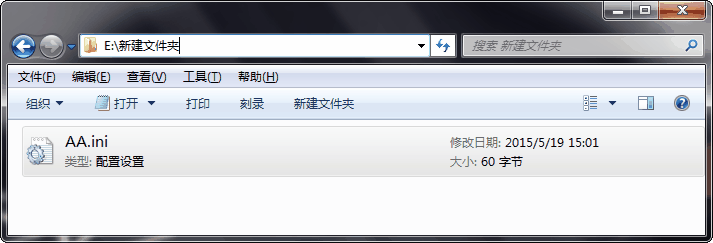C# - 读写INI文件
运行效果:

代码:
1 using System; 2 using System.Collections.Generic; 3 using System.ComponentModel; 4 using System.Data; 5 using System.Drawing; 6 using System.Linq; 7 using System.Text; 8 using System.Threading.Tasks; 9 using System.Windows.Forms; 10 11 //添加相应命名空间 12 using System.Runtime.InteropServices; 13 14 namespace InI 15 { 16 public partial class Form1 : Form 17 { 18 public Form1() 19 { 20 InitializeComponent(); 21 } 22 23 [DllImport("Kernel32")] 24 //创建INI文件 25 //section:小节名程 26 //key:关键字 27 //val:值(可以是变量,字符串,整型,Bool型) 28 //filepath:文件所在路径 29 private static extern long WritePrivateProfileString(string section, string key, string val, string filepath); 30 31 [DllImport("Kernel32")] 32 //读取INI文件 33 //section:查找条目的小节条数 34 //key:关键字 35 //def:制定的条目没有找到时返回的默认值,可以设置为空。 36 //retVal:制定一个字符串缓冲区 37 //size:retVal缓冲区最大的字节数 38 //filepath:文件所在的路径 39 private static extern long GetPrivateProfileString(string section, string key, string def, StringBuilder retVal, int size, string filepath); 40 41 /// <summary> 42 /// 获取路径名称,文件名称,生成新的带有文件名的路径 43 /// </summary> 44 /// <returns>新的路径</returns> 45 public string FilePathName() 46 { 47 string FileName = this.txt_FileName.Text.Trim(); 48 49 string FilePath = this.txt_FilePath.Text.Trim(); 50 51 string NewFileName = FilePath + "\\" + FileName + ".ini"; 52 53 return NewFileName; 54 } 55 56 /// <summary> 57 /// 创建INI文件 58 /// 当INI文件不存在时WritePrivateProfileString会创建INI文件,而已经存在文件的时候会添加到已有的INI文件中。 59 /// </summary> 60 private void button1_Click_1(object sender, EventArgs e) 61 { 62 try 63 { 64 //创建并写入INI文件 65 WritePrivateProfileString("MyQQ", "ID", "192.168.1.230", FilePathName()); 66 67 //在已有的INI文件中追加信息 68 WritePrivateProfileString("MyQQ", "Port", "11000", FilePathName()); 69 70 //用不同的小节名称,在INI文件中追加信息 71 WritePrivateProfileString("MyName", "Port", "11000", FilePathName()); 72 73 this.txt_FilePath.Enabled = false; 74 MessageBox.Show("创建成功!", "提示"); 75 } 76 catch (Exception ex) 77 { 78 MessageBox.Show(ex.Message, "提示"); 79 } 80 } 81 82 /// <summary> 83 /// 读取INI文件 84 /// </summary> 85 /// <param name="sender"></param> 86 /// <param name="e"></param> 87 private void button2_Click_1(object sender, EventArgs e) 88 { 89 try 90 { 91 //创建一个StringBuilder对象 92 StringBuilder temp = new StringBuilder(); 93 GetPrivateProfileString("MyQQ", "ID", "服务器地址读取错误..........", temp, 255, FilePathName()); 94 string MyID = temp.ToString(); 95 GetPrivateProfileString("MyName", "Port", "服务器地址读取错误..........", temp, 255, FilePathName()); 96 string MyPort = temp.ToString(); 97 98 this.label2.Text = "ID:" + MyID + "\n\n" + "Port:" + MyPort; 99 } 100 catch (Exception ex) 101 { 102 MessageBox.Show(ex.Message, "提示"); 103 } 104 } 105 } 106 }
最终:

posted on 2015-05-19 15:05 ultrastrong 阅读(396) 评论(0) 编辑 收藏 举报
